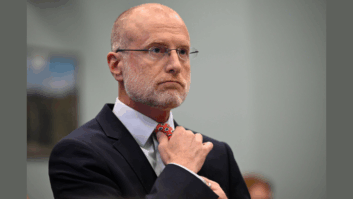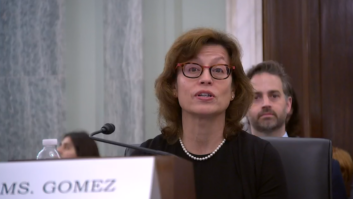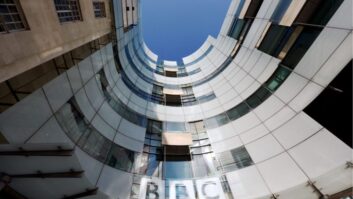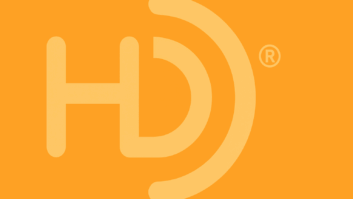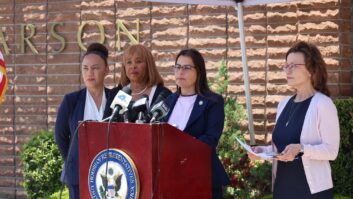INDIANAPOLIS — This is an exciting time for Jeff Smulyan, the chairman, president and CEO of Emmis Communications.
The push is on to promote radio in new Sprint smartphone models that come with the free NextRadio App. Some 13,000 people had launched the NextRadio app on their Sprint HTC One and HTC Evo smartphones as of early September, according to Emmis.
The number was increasing daily, the company said, and is expected to rise sharply as consumers buy more phones and as wireless company Sprint, phone manufacturer HTC and broadcaster Emmis-owned NextRadio conduct a beta eight-city marketing rollout.
Emmis Senior Vice President/Chief Technology Officer Paul Brenner expected the test to go live shortly before the Radio Show convention. Phones have been provided to 40 DJs at stations owned by various groups in those eight markets so they’ll talk about NextRadio on-air, online and on social media. A total of about 14 radio group owners are involved. Sprint and HTC support the effort with their own marketing plans targeting radio.
The NextRadio App does not use a streaming signal to deliver station audio. Instead it provides local over-the-air reception in phones with enabled FM chips — and adds interactive features, if stations opt to support them, such as buy song, rate song, social media coupons and geo-location services.
“If that app is active, you have access to all stations in the listening area,” said Brenner, who added that approximately 2,000 stations had been tuned to through the app as of early September.
“We can see what they’re listening to, for how long and on which stations. User data shows about 15 percent of Sprint customers who buy the new HTC phone are launching the NextRadio app.”
With its Web-based interface, stations can use Emmis’ TagStation to provide data services for radio broadcasting, and deliver interactive elements to the NextRadio app. With the basic, free level of integration, stations can upload branding images to display default artwork in the NextRadio app, as well as call letters, format, station name and slogan.
More than 2,000 stations had signed up for the free level as of early September; and radio groups like Beasley, CBS Radio, Entercom, Greater Media and Hubbard had registered for the additional services like album art and artist information, listener feedback, song tagging capabilities, enhanced advertising options and social integration through TagStation. If stations don’t participate, their audio will still be heard via the app, with no enhancements.
While Brenner has handled the station infrastructure and development part of the Emmis agreement with Sprint to enable FM chips, Smulyan managed its legislative and business facets. Smulyan championed radio capability in cellphones for five years before the Sprint deal was announced in January. He calls the project “the ultimate labor of love.”
Jeff Smulyan spoke to Radio World News Editor/Washington Bureau Chief Leslie Stimson about the effort.

Jeff Smulyan, Emmis Communications chairman, president and CEO, speaks at last year’s Radio Show; Univision Radio President José Valle is at right.
Credit: © NAB
RW: What have the stations committed to?
Smulyan: There’s been unprecedented support; just about everybody in the industry has chipped in to contribute to the $15 million [in ad inventory] to Sprint.
That was step one, raising the money for Sprint on an annual basis. That level of support, frankly, blew me away. I think, of the top 75 groups we have 70 of them. A couple are still considering, and thousands of small stations, all saying, “I want to do my fair share.” I think that’s probably the most unusual…given, at least in the 40 years I’ve been in this in business. So, that’s number one.
The second part, and this is really the most interesting part, is now we want to … roll this out. It’s going to take awhile, because, while we have 2,500 stations with either their logos on the phones or [using] TagStation, we would love every station in America to use either TagStation or build their own interactive system, but make radio truly interactive on smartphones. So that people can see album art. They can get liner notes on albums. They can buy music. They can share information with their friends. They can call into talk shows. They can enter text to win contests. They can rate records. They can download coupons and use location-based services and calendaring.
There’s so many things that our audiences can do to interact with us on a local basis that we think will make their experience with radio much better. But it’s up to all of us to build an ecosystem that does that.
Now, of the 12-to-13,000 radio stations, we want to get a lot of them really involved. We hope every radio station in America, public or private, will find new ways to engage with their audiences because we think it’s a game-changer for our industry.
RW: Public or private meaning you want noncommercial stations involved as well?
Smulyan: We’ve had wonderful discussions with NPR and MPR [Minnesota Public Radio]. Everybody’s looking at this as a new way to relate to our listeners in a device where we don’t go through the data networks, which cost all of us money; it makes it free for our audiences through the terrestrial system and in the device that 300 million Americans carry with them every day.
That’s the goal. We want people to know they can get radio when they’re carrying their cellphone, as they all do every day.
RW: How will the stations promote this?
Smulyan: It’s up to each individual station. We hope everybody will do contests with listeners. … We want to capture the imagination of every individual station in America to promote it.
RW: So it was a monetary and on-air commitment.
Smulyan: We want people to engage their audiences with this device. Leslie, 20 years ago we sold 40 million Walkmen a year. We don’t sell them anymore. This is the Walkman of the future. This is the one device that every American carries with them every day.
RW: As stations sign up for NextRadio, how does that work for the consumer?
Smulyan: If you walk into a Sprint store [and] you buy an HTC, this is the first phone it’s being introduced on. But it will be introduced to their whole product line — if you do that, the NextRadio app will be there. So when you turn your phone on, you look for it and you hit it and the radio comes on. Wherever you live, it will populate with radio.
Also, if you own an HTC phone from Sprint that you bought in the last few years, you can also download that app at the Google Play store. The great majority of this process will be in phones that people are buying now.
RW: They’ve also introduced a special red HTC.
Smulyan: Yes, and you’ll see some fun things, but, I think it’s really up to us now. We’ve been in industry that people have kicked around for a long time. This is our chance for this industry to really fight back. There’s a reason we reach 275 million people a week. It’s because people do care about what we do, and we’ve got to drive that point home.
RW: You mentioned this is the introduction to Sprint product line. Have you and Sprint been talking about starting with these models and then moving onto others?
Smulyan: Yes, this is just the first phone. I’ll leave that to Sprint to announce the others.
RW: And you’re talking to other carriers as well?
Smulyan: We will continue dialogue with every carrier. My goal, and I’ve said this for years: We want to be in 300 million phones in the United States. Sprint has been a wonderful first partner. It’s a major, major breakthrough to have a partner like Sprint.
RW: On the station side, we’ve talked about the app, but there’s also the back-end infrastructure, the TagStation system to insert and track ads and associated data all the way from the automation system to broadcast.
Smulyan: TagStation is sort of the first provider of interactivity. When we started this process, other people were doing that interactivity. They’ve sort of dropped out of the business so we’re the only one. But, I want to stress to people they don’t have to go through TagStation. They can build their own. I’m sure other vendors will crop up. But we I hope they’ll do it. I hope they’ll go to TagStation or build their own, so that every broadcaster can have their own interactivity with their listeners. We think it’s critical.
[Ed. note: Non-Emmis stations that want enhanced content to appear on the NextRadio app need a licensing agreement with Emmis plus its TagStation software, or must build their own source content solution that complies with the mobile app capability and obligations for inventory, reporting and processing mandated by Sprint. With TagStation software, the audio is synchronized with visual elements.]
RW: Is the station infrastructure built out for that?
Smulyan: Yes, we have hundreds of stations on TagStation now and many more online. The ramp-up takes a little time.
RW: You’ve had much work going on. Now, additional things need to happen.
Smulyan: Exactly right and I think we listed the companies [see the story introduction], some of them have already set up their enhanced functions. So if you buy a smartphone from Sprint, and there’s a CBS Radio station or a Beasley station, or Hubbard station, or Greater Media station or Emmis station, all the interactivity will pop up on day one.
RW: About the interactivity on the display. Those stations are poised to make money off enhanced ads, right?
Smulyan: Right, and that will be starting. We know it’s going to take a little while to ramp that up. But the capability’s there now. If you’re WTOP in Washington and you sell McDonald’s an interactive ad, people can download the coupon when they buy the phone.
RW: That’s cool.
Smulyan: That’s my motto for this — “cool and free.” … When people see this app, they say, “That’s cool. That shows me radio in whole new way.” The second part is, it’s free. Not only does it consume a third of the power consumption of streaming, we have no data charges. Every time I stream audio, I pay money to buy bandwidth. And my audience pays money to buy bandwidth. They’re starting to understand that bandwidth has caps. And when they go over caps, it costs them more money. That’s why we think this is so important.
RW: As cars come on the lots with big-screen infotainment systems, how will this look on the display? Will it look like what Pandora and other streamers are doing?
Smulyan: Absolutely. Even cooler. And remember, all of this was done with the suggestion of Kevin Gage [NAB executive vice president and chief technology officer] several years ago, who said we have got to compete in the auto of the future and the smartphone of the future with an interactive display. Now, we were the ones who happened to build it. We put our hand up and said, “We’ll build that.” That’s really key.
RW: So radio’s going to look better in the dash or in your handheld smartphone. You’re going to bring back the cool factor. And now you’re charged with getting as many stations as possible on board?
Smulyan: Right. We want to get every radio broadcaster in America. Remember, the key to the NextRadio system is it is agnostic. It favors no station. Every station in America is displayed. And how they’re displayed is up to them.
We’re making sure that their logo, their station graphics are totally free. All they have to do is download their logo.
We hope they’ll do interactivity as well. When people turn on the radio, we want them to see all the stations, all their logos, all their slogans, all their formats. That requires no expense by a broadcaster. We hope every broadcaster will want to do interactivity, but even … if you don’t do anything, your frequency and your call letters will show up; but the screen will be blank. We’re saying, “Let’s not leave a blank screen for our listeners.”
RW: Are you talking with Sprint about special promotions for the fourth quarter?
Smulyan: We’re working on all sorts of things. The answer is “yes” to any question you ask about talking to Sprint.
RW: Circling back to the money, how much has each station pledged?
Smulyan: We did a formula based on everybody’s revenue and what was a fair share. Without getting into each company, of the 70 radio groups participating, they’re participating as to their fair share based on their industry revenues. Of the largest 75 radio groups, I believe we have 70 committed to this project.
RW: And the Sprint deal was $15 million in advertising inventory a year for three years in exchange for Sprint putting the FM app in at least 30 million phones?
Smulyan: Yes, and we believe that after three years — we don’t plan to pay anymore. We believe that this will be such an important part of the ecosystem that everybody will be clamoring to have this.
RW: You’re thinking the feature will become so popular that Sprint will put FM in more models and other carriers will want to do this, too.
Smulyan: Right.
RW: Is that because Sprint shares in the revenue along with the station when someone downloads a coupon or takes some other type of action?
Smulyan: Right. They’re 30 percent of the enhanced ads. That’s because we’ve got to go back through their architecture. To download a coupon, you’ve go through their architecture.
RW: Emmis gets some of that too, right?
Smulyan: Emmis is managing — we get a fee for managing all the traffic of all of the enhanced ads — just the enhanced ads.
RW: As opposed to the plain ads.
Smulyan: If you run just your regular ad, that’s 100 percent the station’s money… Sprint doesn’t get anything. Emmis doesn’t get anything.
Let’s assume you sell an ad campaign to McDonald’s for Egg McMuffins, [the] same campaign you’ve been selling to McDonald’s for 50 years. That just stays on the station, we just hope more people see it and listen to it because they have a cellphone in their hand.
But if you sell an additional coupon to McDonald’s that downloads when people hear the ad and see the ad, that goes through Sprint backchannel. And by the way, you ought to be able to charge a lot more for that enhanced ad than you would for a normal audio ad. That is where Sprint gets 30 percent and we will manage it.
RW: The backchannel is when Sprint sends the listener something in response to an action the listener has taken, like downloading a coupon.
Smulyan: Yes. On that phone when it downloads to the listener, and that coupon comes up and you take that coupon to McDonald’s and redeem it. The backchannel gives our one-way medium two-way capability.
RW: So you’re doing FM analog. What about HD Radio?
Smulyan: We’re hopeful that’s coming — one step at a time. [IBiquity President/CEO] Bob Struble and I are brothers in arms on this whole process. We think that, ultimately we can do more with data and rich audio and video through HD, but we have to take the first step with analog.
RW: Are you talking to Sprint about that?
Smulyan: Just peripherally.
RW: Is there anything else I should know?
Smulyan: Just remember: Free and cool.
Comment on this or any story. Email [email protected] with “Letter to the Editor” in the subject field.
